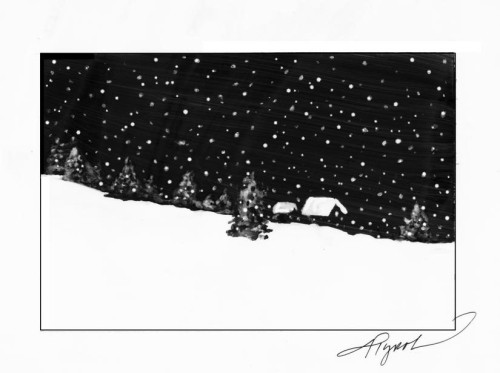
There are few things on this pulsing planet that appear less alive, and more adverse to life, than snow. It falls from the sky in sharp-edged crystals. It blankets the earth in white, silent and still. But there’s life within some snowflakes, life that begins in the clouds before the snow even falls to earth.
All snow and most rain forms when water droplets coalesce around a tiny little bit of something, called a nucleus. Most of the time, that little bit of something is a tiny speck of a mineral, a piece of dust. But water droplets can freeze around any little something, and there are a lot of tiny bits of things floating around.
A certain portion of those bits are airborne bacteria.
Scientists have known for a long time that some snowflakes and raindrops form around bacteria. In fact, for 40 years, certain bacteria have been known to be particularly good at causing droplets to freeze, and they’ve been used to, among other things, make snow at ski areas and to freeze some foods.
About three years ago, however, scientists discovered that there are bacteria in every snowfall, everywhere on earth, even in Antarctica, where there are not that many other living things. This study may have put a damper on sugar-on-snow for a few kids, but since bacteria are in the air to begin with, we’re breathing and eating them anyway.
Of course, not every organism found in snow makes a tasty snack. The snow algae known as watermelon snow have been giving people bellyaches for years, at least when consumed in quantity by thirsty spring hikers and skiers. This red snow algae of the Rockies and Alps hasn’t been found in Vermont or New Hampshire. However, green and orange snow algae have been found here, on the tops of our highest mountains and at alpine ski resorts.
Massachusetts-based snow algae expert Brian Duval, who discovered several snow algae populations in Vermont and New Hampshire, says that we can’t expect to find snow algae in every backyard because it requires a special set of conditions. Life requires liquid water, and snow algae are no exception, he says. When the snow softens, water seeps down to the ground and gives the snow algae a pathway from the soil, where it lies dormant through the summer, up to the surface of the snow pack.
Snow algae require a lot of light – more than is available on a typical midwinter day. So snow algae only grow in places where the snow pack is deep enough to persist into the longer, lighter days of spring.
The water trickling through melting snow is just another freshwater habitat, Duval says. If the algae are around long enough, they will be joined by microscopic grazers, such as rotifers, who will eat it, and decomposers, such as fungi, which eat both the dead algae and the grazers.
It is not a stretch, Duval says, to think of plants that grow under the snow, such as crocuses, as residents of this vertical, snow-bound habitat. Like the snow algae, the melting snow provides the water these plants need to grow, while the spring sun provides the energy.
As spring advances and the snow retreats, some homeowners find their lawns marked with circular dead patches. A fungus called “snow mold” causes the patches.
There are two kinds of snow mold: pink and gray. The surest way to tell them apart is to send a sample to a lab such as the Plant Diagnostic Clinic at the University of Vermont, says Ann Hazelrigg, who is responsible for the clinic.
However, if you act quickly, you can see the fungus for yourself. Take a close look at your lawn after the snow melts but before it dries, because when it dries, the fungus will be gone. On the moist lawn, pink snow mold will appear as fluffy strands on the grass blades. Its color may be white, pink, or a salmon shade. Gray snow mold will be white or gray, and you may be able to see dark, pepper-like flecks. These are sclerotia, which are hardened, dormant remnants of the fungus.
Snow molds grow only in moist conditions, when the temperature is just above freezing. Snow that falls before the ground is frozen in autumn provides ideal conditions. The average homeowner doesn’t need a fungicide to beat snow mold. The grass usually grows back on its own, although fluffing up the flattened grass blades with a rake seems to help.
On a winter’s day, the natural world appears to be sleeping, with snow as its blanket. Snow, however, is no mere covering, but a habitat of its own.

